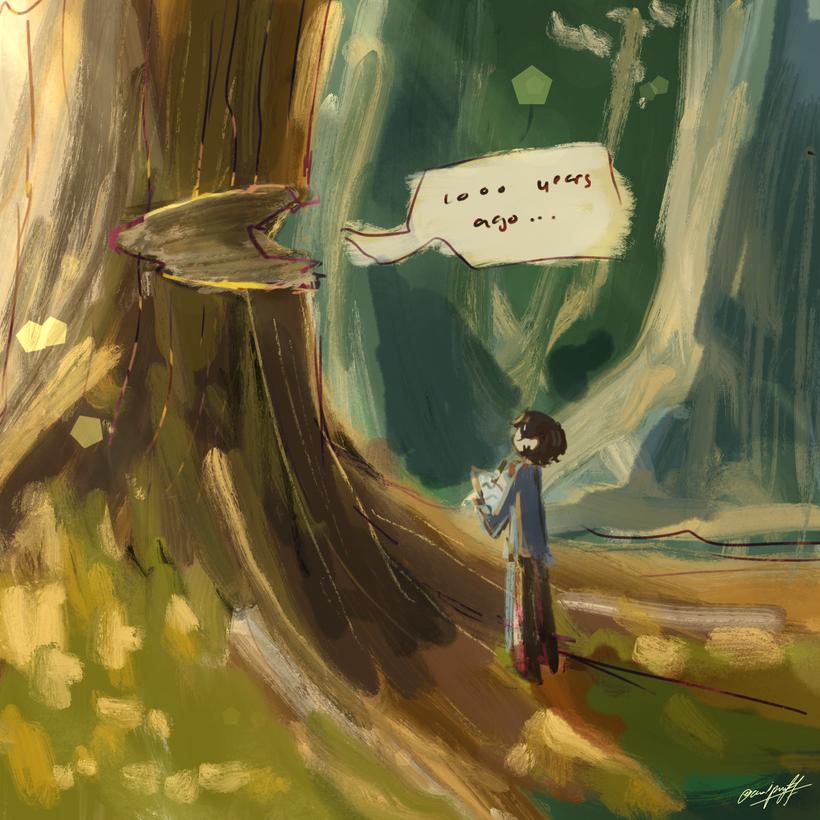
3 minute read
CAN TREE RINGS PREDICT CLIMATE CHANGE?
from 2023 Biology Edition
by scienceholic
How do tree rings work?
Before discussing the interactions between tree rings and climate change, let’s start with how tree rings work Tree rings form based on the growth of trees throughout the years Trees grow outwards, so as they do, they create a “ring” in the trunk (depicted below)
Advertisement
Author: Katelyn Mcphee
Editors: Emily Chen and Hwi-On Lee
Artist: Carys Chan
Mountain, California. It is said to be 5,000 years old.
Scientists have weather records that date back to 1891. But for the purpose of observing general trends in a climate, this amount of data is insufficient. However, if we can use tree rings as weather records; older trees can give us a better idea of what the climate was like hundreds of years ago
In most trees, the light rings come in the spring and summer, and the darker rings come in the fall and winter. The lighter rings tend to be much larger than the darker rings, due to increased growth in the springtime.
The important thing to note here is that the width of each ring can tell scientists a lot about what happened in the area in correspondence to the year
How have we used tree rings to tell time in the past?
The study of past climates is called paleoclimatology; this is mostly what tree rings are used for Cores drilled from Antarctic ice and sediments collected from the bottoms of lakes are also used in paleoclimatology This is the Methuselah (image depicted on right), a bristlecone pine tree in White
Through a method called “cross-dating”, we can also use older wooden objects and compare ring patterns to determine the pattern. Two famous locations that have been studied are the cliff dwellings at Mesa Verde National Park and the Church of the Nativity in Bethlehem, which are 1,000 and 1,500 years old, respectively
The use of tree rings is not new to science at the moment, the International Tree-Ring Data Bank (ITRDB) has tree ring data from over 4,600 locations on six continents
Thriving Together: Biology and Environment
All of this has mostly been collected using an increment borer - a device used to extract the core from a living tree, which causes no long term damage to it. A typical sample from a borer is 4mm in diameter (depicted below).
What are some problems climate scientists have run into?
First of all, this is nature. “If all other factors are held constant” is kind of a really hard premise given the number of factors that can affect tree growth.

Secondly, each species reacts differently While almost every other species will face a decrease in growth if climate change is real, oak populations are expected to increase dramatically
What does this have to do with climate change?
The growth of trees is dependent on the climate While the exact relationship may not be established yet, we know that there is one, and that a consistent climate correlates with consistent tree ring widths (if all other factors are held constant).
Don’t just take this from me take this from an established AMS journal (cited below): “Interpreting conservatively, this study discovered significant statistical relationships between tree-ring widths and seasonal climate for 853 tree populations in the continental United States ”
If we can explain and account for other factors during a time period and the tree rings aren't consistent, then tree rings can predict climate change.

A way to go further with this idea has been to figure out how rising temperatures and humidity affect each tree species by seeing if the tree ring data matches a trend that would match climate change’s projected increased warming and decreased humidity
Thirdly, the only old trees that have survived are the ones who are strong enough to survive. This is a very severe limitation, as we don’t know anything from older trees that didn’t survive the “abuses of time”, as one article puts it.
Trees don’t just predict climate change…
Climate change also affects tree growth a whole lot. Climate scientists have created two different models based on their predictions about climate change: A2 and A1B “A2 and A1B climate scenarios are projected to cause decreased growth rates at 90% and 84% of the sites, respectively” Later in the article, they predict this severe growth decrease to happen before 2050 The Lorax would definitely be disappointed.









